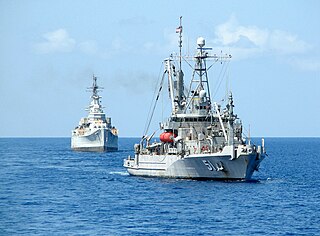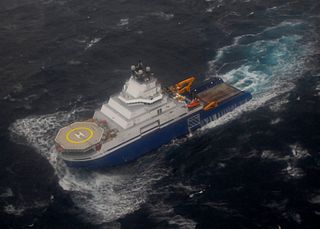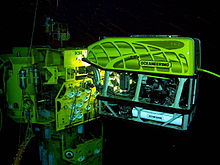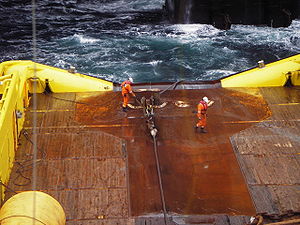
A platform supply vessel (PSV) is a ship specially designed to supply offshore oil and gas platforms and other offshore installations. They typically range from 50 to 100 metres in length and are distinguished by the large open deck area used to store supplies and house equipment and to allow for efficient loading and offloading. The primary function for most of these vessels is logistic support and transportation of goods, tools, equipment, and personnel to and from their destination.

USS Grapple (ARS-53) is a Safeguard-class rescue and salvage ship in the United States Navy. Her home port is Norfolk, Virginia. On 13 July 2006 Grapple was decommissioned from US Navy service and converted to civilian operation by Military Sealift Command. She was redesignated as USNS Grapple.

USNS Safeguard (T-ARS-50), formerly USS Safeguard (ARS-50), is the lead ship of her class and the second United States Navy ship of that name.

AHTSBourbon Dolphin was an anchor handling tug supply vessel of Bourbon Offshore Norway. The ship capsized off the coast of Shetland on April 12, 2007, and sank three days later while preparations were being made to tow her to shore.
Bollard pull is a conventional measure of the pulling power of a watercraft. It is defined as the force exerted by a vessel under full power, on a shore-mounted bollard through a tow-line, commonly measured in a practical test under test conditions that include calm water, no tide, level trim, and sufficient depth and side clearance for a free propeller stream. Like the horsepower or mileage rating of a car, it is a convenient but idealized number that must be adjusted for operating conditions that differ from the test. The bollard pull of a vessel may be reported as two numbers, the static or maximum bollard pull – the highest force measured – and the steady or continuous bollard pull, the average of measurements over an interval of, for example, 10 minutes. An equivalent measurement on land is known as drawbar pull, or tractive force, which is used to measure the total horizontal force generated by a locomotive, a piece of heavy machinery such as a tractor, or a truck,, which is utilized to move a load.
Siem Offshore is an international offshore and subsea shipping company registered on the Cayman Islands with its main offices in Kristiansand, Norway.
Colombo Dockyard PLC (CDPLC) is a ship building company in Sri Lanka and it is based in Colombo. It has built both military and civilian vessels for both local and overseas clients.

In ship design, an inverted bow is a ship's or large boat's bow whose farthest forward point is not at the top. The result may somewhat resemble a submarine's bow. Inverted bows maximize the length of waterline and hence the hull speed, and often have better hydrodynamic drag than ordinary bows. On the other hand, they have very little reserve buoyancy and tend to dive under waves instead of piercing or going over them.

Atlantic Osprey is an anchor handling tug supply (AHTS) vessel, launched 17 April 2003.

An emergency tow vessel, also called emergency towing vessel, (ETV) is a multi purpose boat used by state authorities to tow disabled vessels on high seas in order to prevent dangers to man and environment. The disabled vessel is either towed to a safe haven or kept in place against wind and current until commercial assistance by tug boats has arrived on site or until it has been repaired to the extent of being able to manoeuvre on its own. The need for ETVs as a preventive measure has arisen since the number of available commercial salvage tugs was reduced while potential dangers from individual vessels have increased. E.g. Spain has fourteen, Turkey has eleven, Germany operates eight, Norway has seven, France has five, Sweden three and the Netherlands, Poland, South Africa, Iceland and Finland each have one official emergency tug boat. Australia also operates emergency response vessels. The United Kingdom's four strong ETV fleet was to be disbanded in September 2011 due to budget cuts but the two vessels operating in Scottish waters received an extension of contract until the end of 2011.

USNS Grasp (T-ARS-51) is a Safeguard-class rescue and salvage ship, the second United States Navy ship of that name.

Vladimir Ignatyuk is a Russian icebreaking anchor handling tug supply vessel. She was built by Burrard-Yarrows Corporation in Canada in 1983 as Kalvik as part of an Arctic drilling system developed by BeauDril, the drilling subsidiary of Gulf Canada Resources. After the offshore oil exploration in the Beaufort Sea ended in the early 1990s, she was sold to the Canadian shipping company Fednav in 1997 and renamed Arctic Kalvik. In 2003, she was purchased by Murmansk Shipping Company and transferred to Russia.

USS Avoyel (ATF-150) was a Navajo-class fleet tug built for the United States Navy during World War II. She was the only U.S. Naval vessel to bear the name.

Aiviq is an American icebreaking anchor handling tug supply vessel (AHTS) built in 2012 to support oil exploration and drilling in the Chukchi Sea off Alaska. The vessel's primary task was towing and laying anchors for drilling rigs, and oil spill response. In December 2024, the USCG finalized the contract for the acquisition of Aiviq. After conversion, the vessel will be commissioned to USCG service as a medium icebreaker USCGC Storis.

NOAAS Ferrel was an American hydrographic survey ship that was in commission in the National Oceanic and Atmospheric Administration (NOAA) from 1970 to 2002. Prior to her NOAA career, she was in commission in the United States Coast and Geodetic Survey from 1968 to 1970 as USC&GS Ferrel.

The Safeguard class is a class of Towing, Salvage and Rescue Ship under the United States Navy.
The Bourbon Argos is an anchor handling tug supply vessel from the oil & gas offshore marine servicing company Bourbon Offshore Greenmar, and sails under the Luxembourg flag.

Sea Victory was an ocean-going tugboat. She is best known for her long-distance tows of several of the U.S. Navy's most celebrated and historic vessels. For much of her career she was one of the most powerful American-flagged tugs, which earned her major jobs that could not be completed by smaller vessels. She was launched in 1974 and scrapped, likely in 2023.

Horizon Arctic is an anchor handling tug supply vessel (AHTS) completed in 2016 by Vard Group at its Brattvåg shipyard as Bourbon Arctic for Bourbon Offshore Norway AS, part of the Marseille-based Bourbon group. As of 2023, it is operated by Horizon Maritime of Canada. Under Horizon, it served as the surface support vessel for the Titan submersible during its 2021 and 2022 survey expeditions to the wreck of the Titanic, conducted by OceanGate.

Horizon Maritime Services Ltd is a company which provides vessels and offshore services for arctic duty in Canada and Norway. It is based in St. John's, Newfoundland and Labrador, and its joint ventures include partnerships with two First Nations, the Miawpukek and the Heiltsuk ; in addition, Horizon operates joint ventures with Kotug as Kotug Canada and with Bourbon as Bourbon Horizon.


















